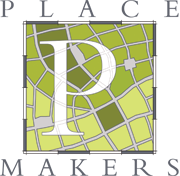 This week I’d like to share a few thoughts on infill and sustainability that coalesced while preparing this week for another Pecha Kucha presentation on Retrofitting Suburbia.
This week I’d like to share a few thoughts on infill and sustainability that coalesced while preparing this week for another Pecha Kucha presentation on Retrofitting Suburbia.
I’ll begin with a little background. My daughter came home from her International Baccalaureate Elementary School with a new sticker in her daily planner proclaiming her an “Eco-Warrior!” She had been awarded the sticker because the teacher saw her picking up trash on her own volition (which I attribute to good parenting, of course). When I asked about it she explained it was ‘sustainability week’ and that she thought she got the sticker because she didn’t get one earlier in the day when the class was discussing ‘sustainability.’ The previously awarded Eco-Warriors had vegetable gardens, hybrid cars, solar panels, and worm/compost bins (In fairness, we do harvest limes in our backyard, which my kids will come to understand the value of after turning 21).
Yes, I hear my fathers voice as I type these next words; “My kids are growing up in a completely different world than I did.” No more sneaking off into the woods to smoke cigarettes as I suspect they’ll be sneaking off to check on their native habitat restoration plantings.
As Andres Duany states, embodied in my daughter’s 3rd Grade class, today’s theological rise of sustainability in confluence with the Great Recession and peak oil instability actually kicked-off our 21st Century around 2008. The changes we have been predicting for years are now afoot.
Now my few thoughts:
1) The power of new technology to change our built and cultural environment. The internal combustion engine begat the Industrial Age and changed our agrarian society to an urban one. We were now more able to access vast landscapes and grow as a nation across the continent.

Steam, then gas, engines connected our nation and the world.
2)
The further refinement of said technology again reshaped our culture towards a more Suburban society. The automobile and its miniature engines allowed each individual to own their own personal train or streetcar system to access the region. Architects and designers actively redesigned how people lived to accommodate for new technology.

Futurama, New York World's Fair
Le Corbu’s ‘City of Tomorrow’ has been implemented across the world with his International Style of towers in a landscaped (sub)urbanism. His clean, modern city was intended to ‘redevelop’ the blight and false ornament of the Victorian / Industrial Age. These same modernist tower blocks continue to threaten our cities’ first tier streetcar neighborhoods to this day.

Images courtesy John Norquist, CNU
3)
Great urban design and architecture creates tremendous value. From Seaside to Alys Beach, these great places have made Florida panhandle coastal scrub some of the most valuable and beautiful real estate in the nation.

Value created in coastal scrubland.
4)
Planning is dead, long live redevelopment! Coastal cities such as San Diego, where the majority of our population lives, cannot continue to grow through sprawl (we all know it’s bad). To keep the lights on, however, cities will only be able to increase tax revenues through infill redevelopment and sprawl repair. This redirection is creating great angst in both the NIMBY and development worlds.

Retrofitting Suburbia and Repairing Sprawl

City of Valencia, California, retrofitting their old mall with Main Street.
5)
Community is the New Technology. Cultivated by the refined technology of our personal / handheld computer devices, we now have greater access to and within our own society. This technology has given us new found access to land we already inhabit. This is seen in the rise of social networks as we are able to communicate more easily with our own places and re-connect in ways we haven’t for several generations; such as community farms and gardens, glee clubs, and civic events.

DPZ CNU Award Winner: Southlands Agricultural Urbanism,
Tsawwassen, British Columbia, Canada.
6)
New Urbanism is in a position to design and leverage our new technology. Cities need our transect and form-based tools to build toward this ‘new’ manner of contextual redevelopment and retrofits. Communities and developers need our context-sensitive expertise to design for an Architecture of Community (Leon Krier) and create meaningful places that both generate taxes and are beloved (i.e.: Steve Mouzon’s Original Green manifesto).

Good job! Moule Polyzoides Architects, Del Mar Station, Pasadena, California.
7)
The kids are alright; but, why should they stay here? My daughters will grow up in more tech-savvy and sustainable world than I can imagine. These kids are now concerned about nature and are more connected to each other than ever before. However, the majority of new plans and planning documents are not savvy enough to inspire kids towards a future they can imagine themselves building towards (Think Wacker Manual of Chicago’s past).

Today's Eco-Warriors.
In an attempt to jump-start economies, cities and towns across the nation are updating their General Plans, Comprehensive Plans and Community Plans to stimulate something. Unfortunately, most are trying to create a new future using the same old planning tools that got us in this mess in the first place. New Urbanists can provide proven new types of tools to convey community-oriented plans for kids growing up today to see a reason to stay in their towns and neighborhoods.
–Howard Blackson
 This week I’d like to share a few thoughts on infill and sustainability that coalesced while preparing this week for another Pecha Kucha presentation on Retrofitting Suburbia.
This week I’d like to share a few thoughts on infill and sustainability that coalesced while preparing this week for another Pecha Kucha presentation on Retrofitting Suburbia.









